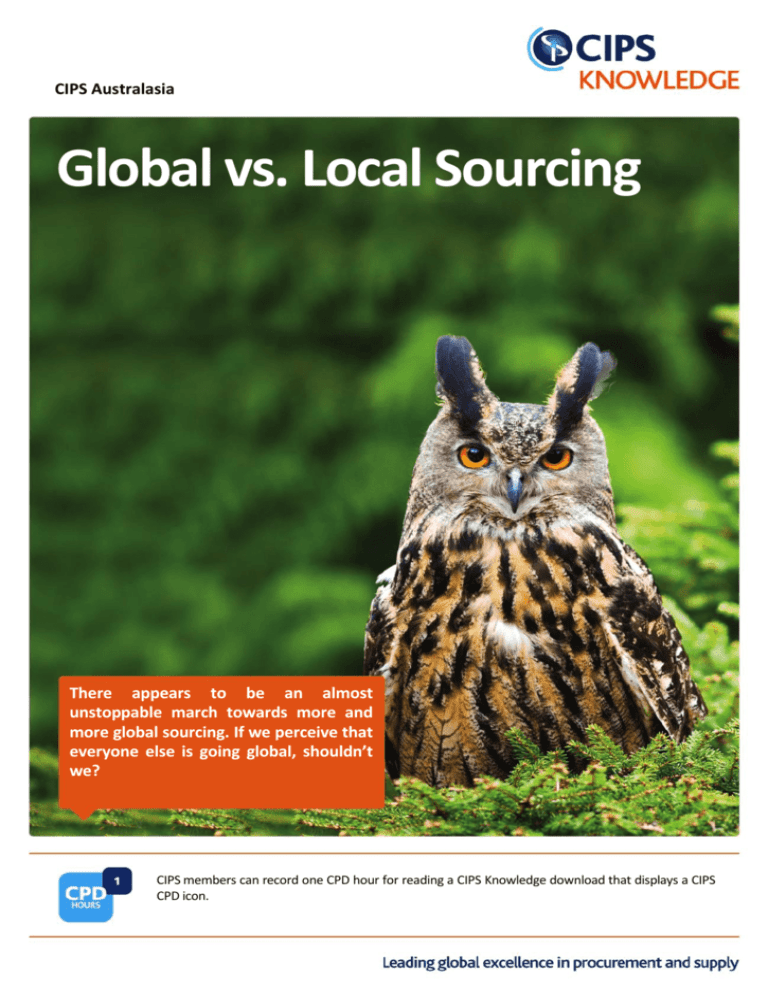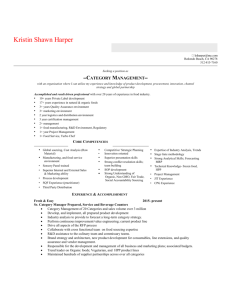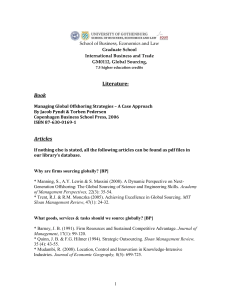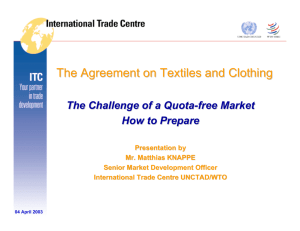Global vs. Local Sourcing
advertisement

CIPS Australasia Global vs. Local Sourcing There appears to be an almost unstoppable march towards more and more global sourcing. If we perceive that everyone else is going global, shouldn’t we? CIPS members can record one CPD hour for reading a CIPS Knowledge download that displays a CIPS CPD icon. Global vs. Local Sourcing- CIPS Australasia Global vs. Local Sourcing There appears to be an almost unstoppable march towards more and more global sourcing; a race to find the next low cost source before the competition; a fear of being left behind. If we perceive that everyone else is going global, shouldn’t we? But is there an alternative view? Is global sourcing inevitable as the way forward for the successful 21st century organisation? Is local sourcing not the better option? This very topic was recently debated at a CIPS Fellows event in London where the case for Global Sourcing was put forward by Professor Richard Lamming (1) and the case for Local Sourcing by Professor Martin Christopher (2). This article is based on the arguments put forward by Lamming and Christopher, and comments from the CIPS Fellows attending the event. The event commenced with the chair questioning whether the basis upon which the decisions taken approximately 10 years ago, that led to increased global sourcing are still relevant today. The question was raised whether the true costs of global sourcing are understood? The argument for local sourcing In support of the argument for local sourcing over global sourcing, Christopher explored four key areas focusing on transport costs, supply chain risk, loss of agility, and sustainability. Transport costs 10 years ago transport costs were falling with oil approximately US$30 per barrel making it relatively cheap to transport goods over long distances. This is no longer the case. The last three years having seen significant rises to a peak of approximately US$147 per in July 2008 and whilst the price has crashed in recent weeks to approximately US$60 in the longer term the price curve is likely to be upward. Roughly each one dollar rise in oil equates to a one per cent increase in transport cost. According to the peak oil theory oil supply and demand are now roughly equal. Therefore, unless there are significant new finds the cost of moving things is going up. Supply chain risk There is increasing awareness of supply chain risk, prompted in part by significant events such as 9/11. Global sourcing extends supply chains, and this increases supply chain risks including: Extended lead times Exchange rate risks which give a lack of certainty to the eventual price to be paid Variable lead times as the supply pipeline extends. For example, problems due to delays caused by port congestion Loss of control, especially of second tier suppliers Reputational risk Global vs. Local Sourcing Loss of IPR as there is often less legislative protection or enforcement in developing countries Geo political risk. E.g. recent events in previously little heard of South Acetia, which came as a surprise to most people Loss of agility There is an imbalance between the need for organisations to be able to respond to events, such as shifts in the market or innovations, and the ability of extended global supply chains to respond quickly. Today there is a need to be demand-driven rather than forecast-driven, which ©CIPS 2013 1 Global vs. Local Sourcing- CIPS Australasia is difficult to achieve with extended lead times. Extended pipelines adversely impact on both time-to-market for new products, and the ability to amend supply if the demand changes. For example, a leading retailer, through offshore sourcing of clothing, needed to determine fashions one year ahead. When the forecast demand failed to materialise, they were faced with a pipeline full of stock for which there was little demand. In addition, hidden costs, through demand amplification, and overstocking in the supply chain. Sustainability As the sustainability agenda moves further into the spotlight, so does global sourcing’s impact, including the carbon footprint, especially through global sourcing’s increased need for transport. Globalisation has exported our domestic carbon footprint elsewhere as goods are manufactured abroad rather than reduced our carbon footprint. The argument for Global Sourcing Lamming countered that there has always has been global trade, although it has grown in scale as technology has changed and enabled it. Human nature is a key reason why global trade will prevail. This is due to the fact that we: expect choice are natural traders hate to think we have paid more than we needed to find ways around problems have a need to develop and improve in order to have a better life An interesting and proposition that global trade leads to peace was made. Nations that trade together are unlikely to go to war. Whilst local sourcing is admirable it is arguably only tenable in a period of international conflict. Global sourcing is necessary to sustain our way of life The ratio between population and land resource available was put forward to support the need for global trade to sustain many of the world’s economies. Based on ecological footprint calculations, (the amount of productive land needed to sustain an individual in their current way of life v. the amount of available productive land) many nations are in deficit and the argument goes that they need to trade globally to sustain that lifestyle. The most sustainable option may not be the obvious one Local sourcing may appear more sustainable but there are a number of documented cases where global sourcing has been found to have less impact on the environment. For example, research by Christchurch University found that when comparing New Zealand lamb sold in the UK with land produced in the UK the New Zealand lamb was found to produce 688 kilograms of CO2 emissions, approximately 25% less than the UK lamb even when taking into account the distances the product was transported. This was in part due to less intensive farming methods needing less use of fertilizer on the grazing land Innovation will provide solutions to the issues posed by global trading Innovation will lead to technology which lessens the environmental impact of global trade. For ©CIPS 2013 2 Global vs. Local Sourcing- CIPS Australasia example, experimentation with fuel cells, which convert hydrogen and oxygen into water, and in the process it produce electricity may lead to cleaner alternative power sources for vehicles and ships. Whilst appearing to hark back to a previous time, wind power is being harnessed through the use of massive power kites with the potential to reduce the fuel used by ships by between 10 and 35% Lamming summed up with 3 key points in favour of global sourcing: global supply becomes the mother of invention global trade contributes to peace people still love getting a bargain and will go where they believe they can get one Do organisations make a proper assessment of their sourcing options? Organisations rarely have the level of detail needed to fully evaluate sourcing options. Measures used are typically crude and it is rare that all cost implications are considered. Whole life costing is in principle a useful tool but it is not an exact science and most organisations struggle to get accurate information on which to base decisions. There are fairly simple models that can be used to aid buyers in their decision making but Lamming cautioned that they should not become a replacement for thinking. Knowledge about the world and the ability to innovate are what is needed. A view was made that as a general rule, predictable products are suitable for low cost country sourcing, whereas more difficult products are more appropriate for local sourcing. In conclusion Consensus at the debate was that neither global sourcing nor local sourcing are inherently right or wrong, but that it is a question of selecting the most appropriate sourcing option for a given requirement. Whilst this conclusion holds no surprises and could have been predicted at the outset of the debate the audience felt that the debate, had been useful to draw out the issues by posing conflicting views. And finally In recent months trading conditions have been particularly volatile, both domestically and internationally, and even in the short time since the debate on local v. global sourcing was held in September, there have been dramatic downturns in commodity markets including oil. The question that the reader may wish to ask themselves is “has the balance moved in favour of local sourcing or global sourcing for their own product areas?” 1) Professor Richard Lamming is Director of the Centre for Research in Strategic Purchasing and Supply, based in the School of Management at the University of Bath. 2) Professor Martin Christopher is Professor of Marketing & Logistics at Cranfield School of Management, based in Cranfield University ©CIPS 2013 3 Global vs. Local Sourcing- CIPS Australasia ©CIPS 2013 4









